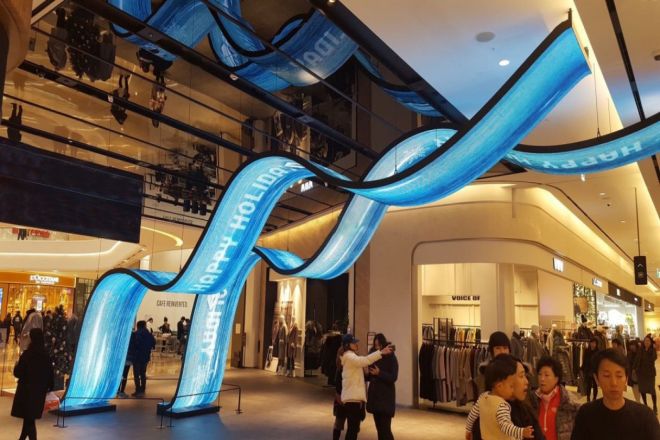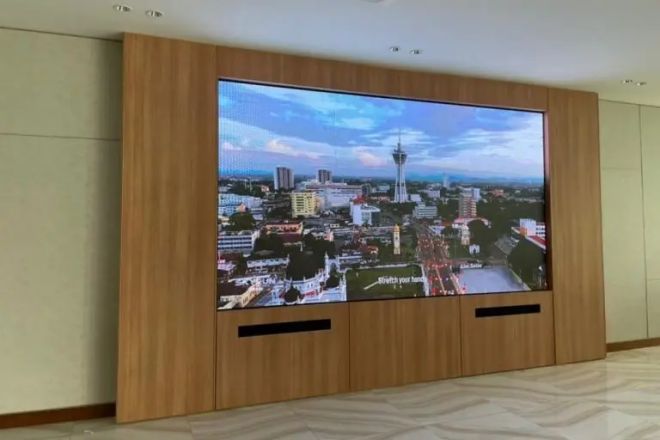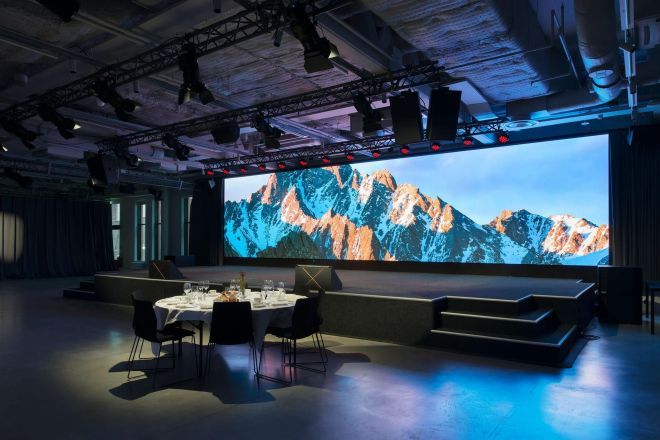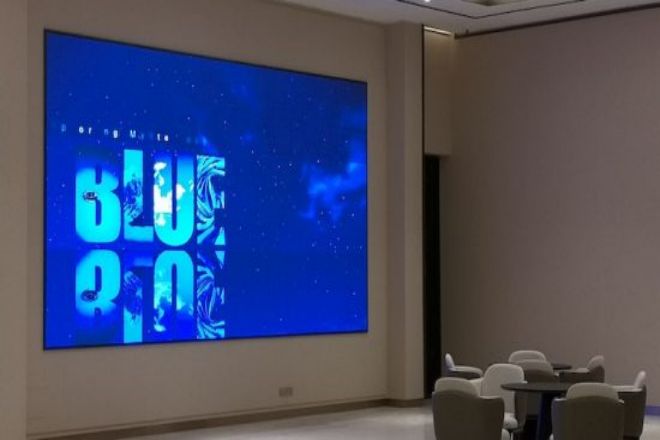소개

기술의 급속한 발전으로, 실내 LED 디스플레이 screens have become an indispensable part of modern commercial display, information dissemination, and entertainment activities.
Its high definition, high brightness, bright colors, and customizable characteristics make LED display screens show great application potential in various fields. However, to ensure that the LED display screen can operate stably for a long time and show the best effect, it is crucial to consider the conditions before installation.
From environmental foundation and electrical configuration to space layout, safety maintenance, and other aspects, every detail may affect the performance and service life of the display screen.
1. Environmental basic conditions

- Ground or wall flatness
When installing indoor LED display screens, the flatness of the ground or wall is a crucial basic condition. The mounting frame of the display screen needs to be firmly attached to these surfaces to ensure that it will not be damaged by vibration or shaking during long-term use.
Therefore, the installation area must be kept flat and firm without obvious bumps or cracks. If the ground or wall is found to be uneven, corresponding leveling measures need to be taken, such as repairing with cement or filling materials or reinforcing the wall structure to ensure the stability of the display screen installation.
- Light conditions
Indoor light conditions have a direct impact on the display effect of LED display screens. Direct sunlight or strong backlight can cause the image on the display screen to become blurred or reflective, seriously affecting the audience’s viewing experience.
Therefore, when installing the display screen, it is necessary to carefully analyze the indoor light conditions and take corresponding measures to avoid these problems. On the one hand, the indoor light can be kept sufficient but not excessive, and a comfortable viewing environment can be created through reasonable lighting design.
On the other hand, if direct sunlight or backlight problems cannot be avoided, auxiliary equipment such as adjustable lighting systems or blackout curtains can be considered to improve the light conditions.
- Temperature and humidity
Temperature and humidity are important factors affecting the performance and life of LED display screens. Generally speaking, the suitable working environment temperature of the display screen should be between 0-40℃, and the humidity range should be between 10%-90%.
Exceeding this range may cause damage to the electronic components of the display screen, resulting in a decrease in display effect or shortened life. Therefore, before installing the display screen, it is necessary to understand and evaluate the temperature and humidity conditions of the installation environment.
If it is found that the environmental conditions do not meet the requirements, appropriate measures need to be taken to adjust or improve them. For example, equipment such as air conditioners or humidifiers can be used to control indoor temperature and humidity to ensure that the display can operate in the best working environment.
At the same time, attention should also be paid to the heat dissipation of the display to ensure that it can remove heat in time during long-term use to avoid damage due to overheating.
2. Electrical conditions
- 전원
When installing an indoor LED display, a stable and reliable power supply is the cornerstone for ensuring the normal operation of the display. Since the power demand of the LED display is relatively high, it is necessary to ensure that the power provided can meet its voltage and current requirements.
When selecting a power socket, attention should be paid to its carrying capacity and stability, and inferior or substandard sockets should be avoided to prevent display failures caused by unstable power supply.
In addition, the layout and direction of the power line should also be considered to ensure its safety and reliability and avoid safety hazards caused by line aging, short circuits, and other problems.
- Circuit matching
The degree of matching between the total power of the display and the circuit is directly related to the stability and safety of its operation. If the circuit carrying capacity is insufficient, it will not be able to meet the power demand of the display, resulting in the display not being able to work properly or frequent failures.
On the contrary, if the circuit carrying capacity is too high and the display power is small, it will cause resource waste and unnecessary cost expenditure. Therefore, when designing the circuit, the total power of the display must be accurately calculated, and the appropriate circuit configuration must be selected according to the actual situation to ensure that the circuit matches the power requirements of the display.
At the same time, since circuit design and installation involve professional knowledge, it is strongly recommended that users hire professionals to operate to ensure the rationality of the circuit design and the safety of the installation.
After the circuit is installed, strict testing and inspection are required to ensure that all electrical connections are correct and the electrical parameters meet the specified requirements to ensure the normal operation and service life of the display.
3. Space and visual conditions

- Space layout
When installing indoor LED displays, space layout is a crucial consideration. First, the size and shape of the installation space need to be accurately measured and evaluated to ensure that the selected display size can perfectly match it.
A display that is too large may make the space appear crowded and affect the overall appearance, while a display that is too small may not meet the viewing needs and reduce the display effect. Therefore, when choosing the size of the display, the actual situation of the space must be fully considered, and scientific and reasonable planning must be carried out.
In addition, in order to optimize the viewing effect, the space layout may need to be adjusted. For example, the hanging height, tilt angle, or viewing position of the display can be adjusted to ensure that the audience can view the display content at the most comfortable angle.
At the same time, you can also consider using decorative elements of the surrounding environment, such as walls, ceilings, or furniture, to create a more harmonious visual effect and enhance the overall atmosphere.
- Visual conditions
In addition to the spatial layout, visual conditions are also an important factor affecting the display’s viewing effect. First, it is necessary to reserve enough viewing distance to ensure that the audience can clearly see the content on the display.
Generally speaking, the effective viewing distance should be controlled between 5 meters and 50 meters, and the specific value needs to be adjusted according to the actual size and resolution of the display. In addition, it is also necessary to avoid viewing distances that are too close or too far to avoid affecting the viewing effect and comfort.
Secondly, the viewing angle is also a factor that needs to be considered. In order to ensure that the audience can get a good viewing experience at different angles, the viewing angle of the display should be as large as possible. Generally speaking, a viewing angle within ±60° is an ideal choice.
However, in actual applications, it is also necessary to adjust according to the specific installation environment and viewing needs. For example, on occasions where the audience is more dispersed, it may be necessary to choose a display with a wider viewing angle; on occasions where the audience is concentrated, the viewing angle can be appropriately reduced to improve the display effect.
Finally, different installation methods will also have an impact on visual conditions. For example, wall-mounted installation can save space and highlight the visual effect of the display screen, while ceiling-mounted installation can adjust the height and angle as needed to optimize the viewing effect.
Therefore, when choosing an installation method, it is necessary to comprehensively consider multiple factors such as space layout, viewing needs, and visual effects to choose the most suitable installation method.
At the same time, it is also necessary to pay attention to details during the installation process, such as the stability of the fixings and the concealment of the lines, to ensure the safe and stable operation of the display screen.
4. Safety and maintenance conditions
- Safe distance and fixation
When installing indoor LED display screens, it is crucial to ensure a safe distance between the display screen and surrounding objects. This is not only to prevent viewers or staff from accidentally touching or colliding with the display screen, causing personal injury or equipment damage, but also to ensure the stability and safety of the display screen during long-term use.
Therefore, before installation, the layout of the display screen should be carefully planned to ensure that it maintains a certain safe distance from surrounding objects such as walls, ceilings, and furniture.
At the same time, using a suitable bracket or fixture for installation is also an important link that cannot be ignored. The quality of the bracket or fixture is directly related to the stability and safety of the display screen.
Therefore, when selecting a bracket or fixture, you should ensure that it has sufficient load-bearing capacity and stability to meet the weight and size requirements of the display. During the installation process, you should strictly follow the operating procedures to ensure that the bracket or fixture is firmly installed without looseness or tilting.
- Dust prevention and ventilation
The impact of impurities such as dust and smoke in the indoor environment on the LED display cannot be ignored. These impurities are easy to adhere to the surface of the display or enter its interior, affecting the display effect and even causing equipment failure.
Therefore, keeping the display clean is one of the important measures to maintain its normal operation. Regularly wiping the surface of the display with a soft cloth and a special detergent can effectively remove dust and dirt and maintain its clarity and brightness.
In addition, the installation environment also needs to have a good ventilation system. The LED display will generate a certain amount of heat during operation.
If the ventilation is poor, it will cause heat accumulation, affect the heat dissipation effect of the display, and thus shorten its service life. Therefore, when installing the display, you should ensure that the installation environment has good ventilation conditions, such as setting up ventilation equipment such as air conditioners and fans to keep the indoor air circulation and temperature appropriate.
- Professional installation and commissioning
Asking professional installation masters to carry out the construction is the key to ensuring the installation quality and subsequent commissioning. Professional installers have rich experience and professional skills and can accurately assess the installation environment, select the appropriate installation plan, and install it according to the operating procedures.
They can also provide comprehensive technical support and after-sales service to ensure that the display can operate normally and meet the use requirements after installation.
After the installation is completed, timely debugging is also an indispensable link. During the debugging process, it is necessary to test and verify the various functions of the display to ensure that its display effect, color reproduction, brightness, and other parameters meet the design requirements.
At the same time, the display control system needs to be debugged and optimized to ensure that it can operate stably and reliably. Through the guarantee of professional installation and debugging, users can be provided with a high-quality, high-performance indoor LED display solution.
5. Other considerations

- Display brightness and adaptive adjustment
In indoor environments, the brightness adjustment of LED displays is an important consideration. Compared with outdoor environments, indoor light conditions are relatively stable, and the audience is closer to the display, so the brightness of the display should be lowered accordingly to avoid excessively bright light causing discomfort or visual fatigue to the viewer.
At the same time, a display with an adaptive adjustment function can automatically adjust the brightness according to changes in ambient light to maintain the best display effect and viewing comfort. This adaptive brightness adjustment not only helps save energy, protect the environment, and reduce unnecessary energy waste but also effectively protects the eyes of viewers and avoids visual damage caused by watching high-brightness screens for a long time.
- Profile and structure selection
When selecting the profile and structure of an indoor LED display, it is necessary to fully consider multiple factors such as its use environment, installation conditions, and display effects. For small indoor displays, lightweight and easy-to-install profiles such as aluminum alloy profiles are usually selected.
These profiles not only have high strength and stability but also meet the lightweight requirements of small displays. For large indoor displays or displays that require special installation methods, such as hoisting or wall-mounted installation, it may be necessary to choose a more sturdy steel structure as support.
In addition, the size of the profile frame is another detail that needs attention. In order to ensure the stability and beauty of the display installation, the size of the profile frame should be slightly larger than the actual size of the display to leave enough space for fixing and installation.
This not only prevents safety hazards such as shaking or falling off of the display during installation but also makes the overall installation effect neater and more beautiful.
At the same time, when selecting profiles and structures, it is also necessary to consider their corrosion resistance, weather resistance, and other properties to ensure that the display can operate stably and for a long time in various complex environments.
결론
In summary, installing indoor LED display screens is a complex and delicate process, which requires full consideration of environmental, electrical, spatial, safety, and maintenance conditions.
Only on the basis of a comprehensive understanding and satisfaction of these conditions can the stable operation and long-term use of the display screen be ensured. We encourage all users who plan to install indoor LED display screens to conduct sufficient research and planning before the project is implemented to ensure that all conditions are effectively guaranteed.
At the same time, we also look forward to the continuous advancement and innovation of technology, and the indoor LED display screen can show its unique charm and value in more fields, bringing more convenience and surprises to our lives and work.
마지막으로 LED 디스플레이 화면에 대해 더 알고 싶다면, 우리에게 연락해주세요.
